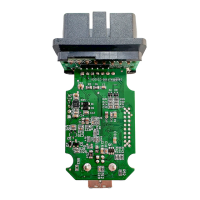Power controller (PWR) RM0090
118/1749 RM0090 Rev 18
5.1.2 Battery backup domain
Backup domain description
To retain the content of the RTC backup registers, backup SRAM, and supply the RTC when
V
DD
is turned off, V
BAT
pin can be connected to an optional standby voltage supplied by a
battery or by another source.
To allow the RTC to operate even when the main digital supply (V
DD
) is turned off, the V
BAT
pin powers the following blocks:
• The RTC
• The LSE oscillator
• The backup SRAM when the low-power backup regulator is enabled
• PC13 to PC15 I/Os, plus PI8 I/O (when available)
The switch to the V
BAT
supply is controlled by the power-down reset embedded in the Reset
block.
Warning: During t
RSTTEMPO
(temporization at V
DD
startup) or after a PDR
is detected, the power switch between V
BAT
and V
DD
remains
connected to V
BAT
.
During the startup phase, if V
DD
is established in less than
t
RSTTEMPO
(Refer to the datasheet for the value of t
RSTTEMPO
)
and V
DD
> V
BAT
+ 0.6 V, a current may be injected into V
BAT
through an internal diode connected between V
DD
and the
power switch (V
BAT
).
If the power supply/battery connected to the V
BAT
pin cannot
support this current injection, it is strongly recommended to
connect an external low-drop diode between this power
supply and the V
BAT
pin.
If no external battery is used in the application, it is recommended to connect the V
BAT
pin to
V
DD
with a 100 nF external decoupling ceramic capacitor in parallel.
When the backup domain is supplied by V
DD
(analog switch connected to V
DD
), the
following functions are available:
• PC14 and PC15 can be used as either GPIO or LSE pins
• PC13 can be used as a GPIOas the RTC_AF1 pin (refer to Table 37: RTC_AF1 pin for
more details about this pin configuration)
Note: Due to the fact that the switch only sinks a limited amount of current (3 mA), the use of PI8
and PC13 to PC15 GPIOs in output mode is restricted: the speed has to be limited to 2 MHz
with a maximum load of 30 pF and these I/Os must not be used as a current source (e.g. to
drive an LED).

